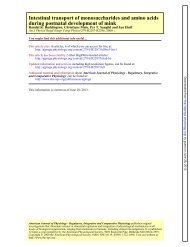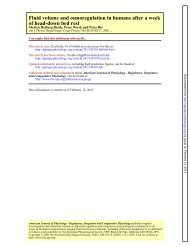Mechanical strain regulation of the Chicken glypican-4 gene ...
Mechanical strain regulation of the Chicken glypican-4 gene ...
Mechanical strain regulation of the Chicken glypican-4 gene ...
Create successful ePaper yourself
Turn your PDF publications into a flip-book with our unique Google optimized e-Paper software.
RESULTS<br />
Identification <strong>of</strong> <strong>the</strong> chicken GPC-4 <strong>gene</strong> in chicken ESG<br />
RNA fingerprinting was used to identify <strong>gene</strong>s involved in <strong>the</strong> eggshell calcification.<br />
Differential screening was performed between cDNA derived from ESG biopsies from<br />
two different states <strong>of</strong> <strong>the</strong> daily egg cycle: 1- no egg resides in <strong>the</strong> ESG, no calcification<br />
and no mechanical <strong>strain</strong>; 2- <strong>the</strong> egg resides in <strong>the</strong> ESG, at <strong>the</strong> peaks <strong>of</strong> eggshell<br />
calcification and <strong>of</strong> mechanical <strong>strain</strong>. We isolated and sequenced 14 clones that<br />
appeared to be up-regulated at <strong>the</strong> time <strong>of</strong> eggshell calcification. One <strong>of</strong> <strong>the</strong>se clones – a<br />
382-bp cDNA sequence – showed 80% similarity to <strong>the</strong> mouse K-<strong>glypican</strong> (GenBank,<br />
accession number X83577). This sequence was extended to both <strong>the</strong> 3’ and 5’ directions,<br />
resulting in a complete 3’ region <strong>of</strong> <strong>the</strong> <strong>gene</strong>, and a 5’ region with a missing part<br />
estimated to comprise <strong>the</strong> first 71 bp <strong>of</strong> <strong>the</strong> open reading frame, according to <strong>the</strong><br />
mammalian homologues (Fig. 2). The amplified PCR fragments were subcloned, and 11<br />
randomly selected subclones were analysed by sequencing, <strong>the</strong> obtained sequence was<br />
additionally verified by RT-PCR. Analysis <strong>of</strong> <strong>the</strong> obtained sequence revealed 77 and 78%<br />
similarity to <strong>the</strong> mouse and human GPC-4 <strong>gene</strong>s, respectively, with two stretches<br />
showing 92% homology. Multiple alignment <strong>of</strong> <strong>the</strong> predicted protein product <strong>of</strong> <strong>the</strong> GPC-<br />
4 <strong>gene</strong> showed 74 and 75% identity to <strong>the</strong> amino acid sequences <strong>of</strong> mouse and human<br />
GPC-4, respectively. Of most importance is <strong>the</strong> conservancy within <strong>the</strong> sequence <strong>of</strong><br />
motifs that is characteristic <strong>of</strong> all members <strong>of</strong> <strong>the</strong> <strong>glypican</strong> family; <strong>the</strong>se motifs includ <strong>the</strong><br />
<strong>glypican</strong> signature region and <strong>the</strong> GPI binding site (Fig.2). Out <strong>of</strong> <strong>the</strong> 13 cystein residues<br />
known to be conserved among all mammalian <strong>glypican</strong>s, 12 were found to be conserved<br />
also in <strong>the</strong> avian GPC-4. One cystein residue at position 224 corresponding to <strong>the</strong> mouse<br />
sequence was replaced by glycine as confirmed by RT-PCR analysis <strong>of</strong> cDNA obtained<br />
from different avian tissues.<br />
Temporal and spatial expression <strong>of</strong> <strong>the</strong> chicken GPC-4 <strong>gene</strong> during eggshell formation<br />
Temporal and spatial localization <strong>of</strong> <strong>the</strong> avian GPC-4 in <strong>the</strong> ESG during <strong>the</strong> eggshell<br />
formation cycle was performed by in situ hybridization (Fig. 3). Very low levels <strong>of</strong><br />
expression <strong>of</strong> <strong>the</strong> GPC-4 <strong>gene</strong> was observed prior to <strong>the</strong> entry <strong>of</strong> <strong>the</strong> egg into <strong>the</strong> ESG,<br />
while <strong>the</strong> egg was still located in <strong>the</strong> magnum or isthmus (Fig. 3A), or 1 h after <strong>the</strong> egg<br />
9







